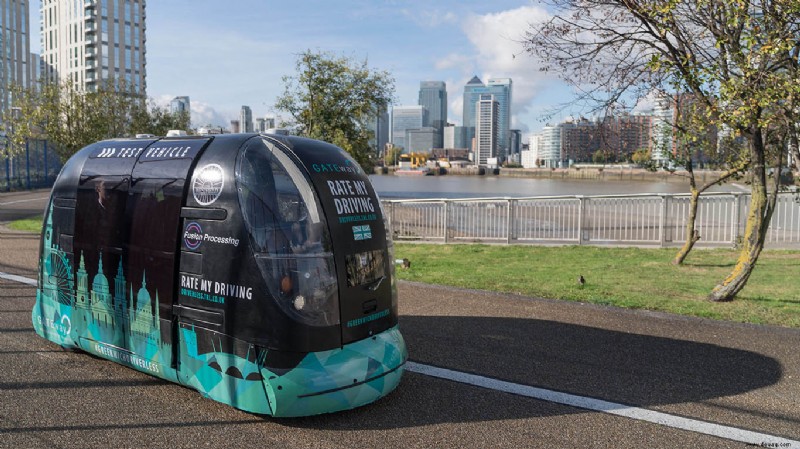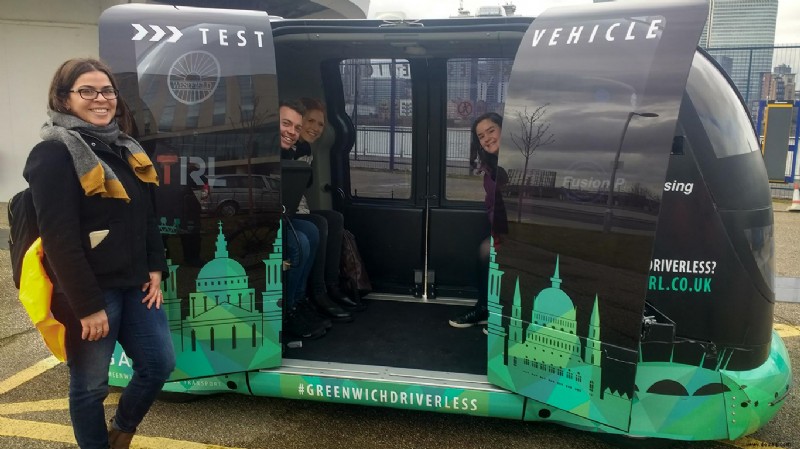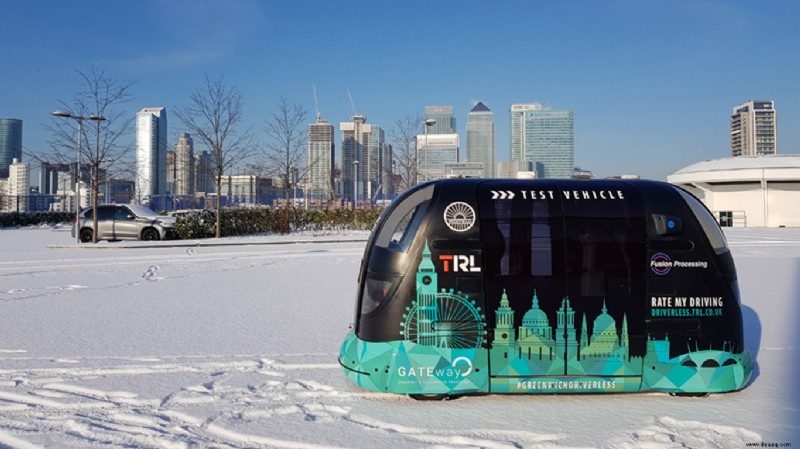Die Frau, die etwas beschwipst den Fluss in Greenwich entlang nach Hause schlurfte, hatte wahrscheinlich nicht erwartet, dass ein automatisierter Pod ihr bei jedem Stolpern folgt. Als ob sie sich aufgrund ungeschickter guter Manieren zurückhalten würde, folgte ihr das selbstfahrende Fahrzeug den Radweg hinunter und konnte nicht herumkommen, ohne ihr zu nahe zu kommen.

Im Gegensatz zu den meisten unserer Annahmen über fahrerlose Autos – vielleicht verzerrt durch die jüngsten amerikanischen Versuche – bewegen sich die automatisierten Pods in diesem speziellen Versuch genau so vorsichtig, langsam und bewusst, während sie den Fluss in der Nähe der O2 Arena entlangfahren.
Das GATEway-Projekt testet nicht die Technologie hinter fahrerlosen Autos, obwohl es viele Ingenieure vor Ort gibt, die an Hardware und Software herumfummeln. Stattdessen versucht es zu verstehen, wie wir Menschen über die Maschinen denken. „Dieses ganze Projekt soll die öffentliche Akzeptanz verstehen, was die Leute darüber denken und wie sie darauf reagieren“, sagt Jim Hutchinson, CEO der Software- und Systemdesigner Fusion Processing.
Erste Recherchen deuten darauf hin, dass wir überwiegend positiv eingestellt sind, obwohl es viele Sicherheitsbedenken gibt. „Sicherheit wird immer kommentiert“, sagt Kristen Fernández-Medina, leitende Psychologin bei TRL und technische Leiterin bei GATEway. „Die Leute sehen es als potenziell positiv, sie können die Vorteile sehen, menschliche Fehler aus der Gleichung herauszunehmen … aber dann haben Sie die andere Seite der Dinge, einschließlich der Sache mit der Cybersicherheit, die die Leute ein wenig ansprechen. Die Menschen müssen wissen, ob sie ihm als Bewohner und als Fußgänger vertrauen können.“

Eine Fahrt in einem GATEway-Fahrzeug hilft, Sicherheitsbedenken auszuräumen – sie bewegen sich langsam und methodisch. Die Pods sind die gleichen wie die, die in Heathrow verwendet werden, um Flieger vom Parkplatz zum Terminal zu befördern, aber anstatt einen eigenen Fahrstreifen zu haben, benutzen sie hier den Radweg – sehr zum Ärger einiger Radfahrer, anscheinend.
Sie arbeiten mit einer Kombination aus LIDAR, Kameras, Ultraschall und Radar und profitieren auch von der bereits bestehenden Kartierung des Gebiets aus einem früheren fahrerlosen Projekt. Das „Denken“ findet alles an Bord statt – Sie können buchstäblich fühlen, wie das Fahrzeug anhält und „denkt“, wie Frost es nennt, anhalten und starten, wenn es „in Schwierigkeiten gerät“ – mit Überwachung und Verfolgung von einer zentralen Station über 4G . Dieses System ist nicht ohne Probleme, wie ich herausfand, als meine Fahrt Verspätung hatte, weil es sein Datenlimit überschritten hatte, wie ein großes, autoförmiges Pay-as-you-go-Telefon.
Ein britischer Ansatz
Meine Fahrt in der Viersitzer-Kapsel findet einen Tag statt, nachdem die US-Behörden enthüllten, dass ein Fußgänger von einem fahrerlosen Uber-Auto in Arizona getötet worden war – eine Tatsache, die natürlich im Gespräch mit Hutchinson von Fusion Processing und Andy Frost, Leiter Entwicklung und Versuche bei, zur Sprache kam Kapselhersteller Westfield Technology Group. Als die Kapsel, die uns trug, langsam den Weg entlang rollte, an belebten Stellen langsamer wurde und anhielt, wenn ihr jemand in den Weg kam, war ihre Haltung zum Uber-Fall vorsichtig:Es ist zu früh, um die Ursachen zu nennen.
Es ist schwer vorstellbar, dass sich jemand auf einem GATEway-Pod unsicher fühlt. Es bewegt sich langsam und erreicht eine Höchstgeschwindigkeit von 5,5 Meilen pro Stunde, während der Uber-Absturz mit 40 Meilen pro Stunde auf einer Straße mit 45 Meilen pro Stunde passierte. It moves even more slowly when there’s a likelihood of people, such as the entrance to a construction site or the disembarkation point for a ferry.
It’s not a “thrill ride”
“We reduce speed to be good neighbours,” says Frost, saying it’s not a “thrill ride”.
Indeed, it’s clear the British are taking a different road to American developers when it comes to driverless cars. Arizona opened up its roads for testing, and there are a host of private corporations testing on public roads there and elsewhere across the country. In the UK, many of the tests are partnerships between industry, government and academia:the GATEway project involves Westfield, Heathrow, and Fusion Processing, as well as research group TRL and the University of Greenwich, with some funding from quango Innovate UK. That’s not to say companies haven’t had access to public roads, with Nissan having a few close calls in a test in East London last year, but trials have so far been limited rather than long-running.

See related Uber’s autonomous cars banned in Arizona following fatal collision“People are super comfortable riding in elevators”:Can we shape people’s attitude to driverless cars?
They also haven’t all focused on the technology. While Uber et al in Arizona are trying to make a level-five automated car to carry passengers, the GATEway project wants to see how driverless cars could be used and how we’ll react to them. “It’s starting a conversation, showcasing the technology and the use cases, and getting people involved in the development process,” says Fernandez-Medina. “It’s not just putting the vehicles on the road; it’s how they’re going to impact people.”
That starts from the inside out, as the project also considers what design elements need to be included to ensure people feel safe, not only with being driven in an automated car, but also with being shut into a pod with three other strangers. Frost says passengers are often “a bit shocked” to see there’s no steering wheel, but most people are excited to go for a driverless ride, even if a safety steward is at the controls. Frost was ours for the trip; he had to take over the controls and drive with a joystick after two pods tried to be in the same waiting point at the same time.
“Down here, there aren’t any rules”
One change from user feedback has been a reduction in window tint. Pedestrians like being able to see in, says Frost, while those inside find it less intimidating to share the pod with others if it isn’t as closed off from the outside world.
Figuring out how that outside world will work with the pod isn’t easy, either. While it may sound comparatively simple to have a driverless project on bike paths rather than motorways, it brings unique challenges. Hutchinson notes that roads have rules which people, be they drivers or pedestrians, normally follow. “Down here, there aren’t any rules – it’s a free-for-all,” adds Frost.
When a pod ambles past, how will pedestrians react? They mostly pull out their phones to snap photos, judging from my 3.5km ride. What if a pod sneaks up behind a headphone-wearing pedestrian? There needs to be a way to pass people without alarming them. If a cyclist passes on the inside – which they do, Frost says – how can the pod spot it and make space without causing trouble?
And what happens if a drunk lady staggers back and forth across the pathway, leaving the pod edging to the left and back again as it tries to pass her? Hilarity, mostly – Frost says there was plenty of laughter both inside and outside the pod.
Images:GATEway Project